The NVIDIA GeForce GTX 980 Review: Maxwell Mark 2
by Ryan Smith on September 18, 2014 10:30 PM ESTPower, Temperature, & Noise
As always, last but not least is our look at power, temperature, and noise. Next to price and performance of course, these are some of the most important aspects of a GPU, due in large part to the impact of noise. All things considered, a loud card is undesirable unless there’s a sufficiently good reason – or sufficiently good performance – to ignore the noise.
Having already seen the Maxwell architecture in action with the GTX 750 series, the GTX 980 and its GM204 Maxwell 2 GPU have a very well regarded reputation to live up to. GTX 750 Ti shattered old energy efficiency marks, and we expect much the same of GTX 980. After all, NVIDIA tells us that they can deliver more performance than the GTX 780 Ti for less power than the GTX 680, and that will be no easy feat.
| GeForce GTX 980 Voltages | ||||
| GTX 980 Boost Voltage | GTX 980 Base Voltage | GTX 980 Idle Voltage | ||
| 1.225v | 1.075v | 0.856v | ||
We’ll start as always with voltages, which in this case I think makes for one of the more interesting aspects of GTX 980. Despite the fact that GM204 is a pretty large GPU at 398mm2 and is clocked at over 1.2GHz, NVIDIA is still promoting a TDP of just 165W. One way to curb power consumption is to build a processor wide-and-slow, and these voltage numbers are solid proof that NVIDIA has not done that.
With a load voltage of 1.225v, NVIDIA is driving GM204 as hard (if not harder) than any of the Kepler GPUs. This means that all of NVIDIA’s power optimizations – the key to driving 5.2 billion transistors at under 165W – lie with other architectural optimizations the company has made. Because at over 1.2v, they certainly aren’t deriving any advantages from operating at low voltages.
Next up, let’s take a look at average clockspeeds. As we alluded to earlier, NVIDIA has maintained the familiar 80C default temperature limit for GTX 980 that we saw on all other high-end GPU Boost 2.0 enabled cards. Furthermore as a result of reinvesting most of their efficiency gains into acoustics, what we are going to see is that GTX 980 still throttles. The question then is by how much.
| GeForce GTX 980 Average Clockspeeds | |||
| Max Boost Clock | 1252MHz | ||
| Metro: LL |
1192MHz
|
||
| CoH2 |
1177MHz
|
||
| Bioshock |
1201MHz
|
||
| Battlefield 4 |
1227MHz
|
||
| Crysis 3 |
1227MHz
|
||
| TW: Rome 2 |
1161MHz
|
||
| Thief |
1190MHz
|
||
| GRID 2 |
1151MHz
|
||
| Furmark |
923MHz
|
||
What we find is that while our GTX 980 has an official boost clock of 1216MHz, our sustained benchmarks are often not able to maintain clockspeeds at or above that level. Of our games only Bioshock Infinite, Crysis 3, and Battlefield 4 maintain an average clockspeed over 1200MHz, with everything else falling to between 1151MHz and 1192MHz. This still ends up being above NVIDIA’s base clockspeed of 1126MHz – by nearly 100MHz at times – but it’s clear that unlike our 700 series cards NVIDIA is much more aggressively rating their boost clock. The GTX 980’s performance is still spectacular even if it doesn’t get to run over 1.2GHz all of the time, but I would argue that the boost clock metric is less useful this time around if it’s going to overestimate clockspeeds rather than underestimate. (ed: always underpromise and overdeliver)
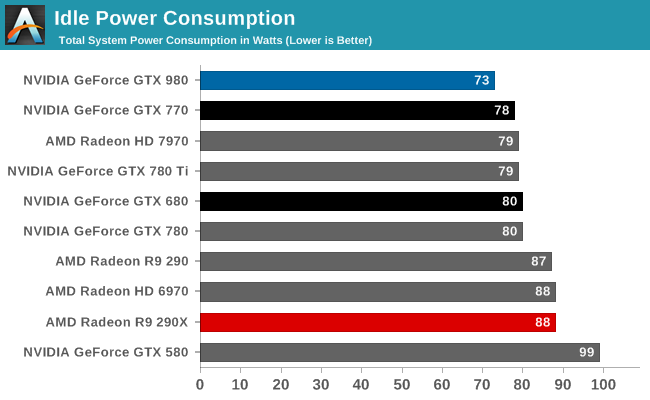
Starting as always with idle power consumption, while NVIDIA is not quoting specific power numbers it’s clear that the company’s energy efficiency efforts have been invested in idle power consumption as well as load power consumption. At 73W idle at the wall, our testbed equipped with the GTX 980 draws several watts less than any other high-end card, including the GK104 based GTX 770 and even AMD’s cards. In desktops this isn’t going to make much of a difference, but in laptops with always-on dGPUs this would be helpful in freeing up battery life.

Our first load power test is our gaming test, with Crysis 3. Because we measure from the wall, this test means we’re seeing GPU power consumption as well as CPU power consumption, which means high performance cards will drive up the system power consumption numbers merely by giving the CPU more work to do. This is exactly what happens in the case of the GTX 980; at 304W it’s between the GK104 based GTX 680 and GTX 770, however it’s also delivering 30% better framerates. Accordingly the power consumption of the GTX 980 itself should be lower than either card, but we would not see it in a system power measurement.
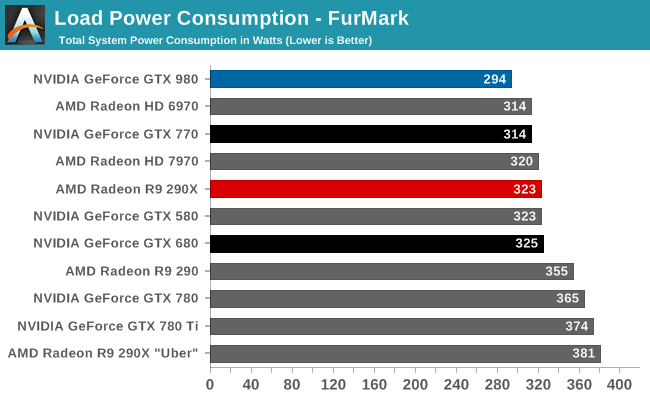
For that reason, when looking at recent generation cards implementing GPU Boost 2.0 or PowerTune 3, we prefer to turn to FurMark as it essentially nullifies the power consumption impact of the CPU. In this case we can clearly see what NVIDIA is promising: GTX 980’s power consumption is lower than everything else on the board, and noticeably so. With 294W at the wall, it’s 20W less than GTX 770, 29W less than 290X, and some 80W less than the previous NVIDIA flagship, GTX 780 Ti. At these power levels NVIDIA is essentially drawing the power of a midrange class card, but with chart-topping performance.
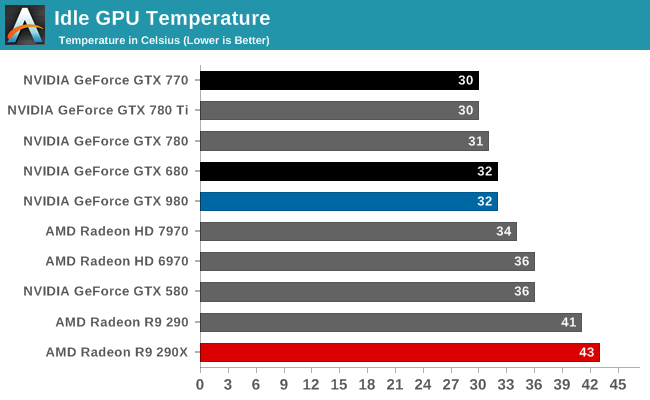
Moving on to temperatures, at idle we see nothing remarkable. All of these well-designed, low idle power designs are going to idle in the low 30s, especially since they’re not more than a few degrees over room temperature.

With an 80C throttle point in place for the GTX 980, it’s here where we see the card top out at. The fact that we’re hitting 80C is the reason why the card is exhibiting clockspeed throttling as we saw earlier. NVIDIA’s chosen fan curve is tuned for noise over temperature, so it’s letting the GPU reach its temperature throttle point rather than ramp up the fan (and the noise) too much.
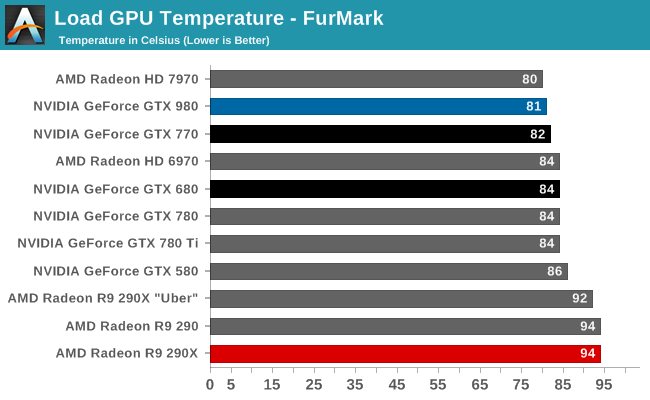
Once again we see the 80C throttle in action. Like all GPU Boost 2.0 NVIDIA cards, NVIDIA makes sure their products aren’t going to get well over 80C no matter the workload.
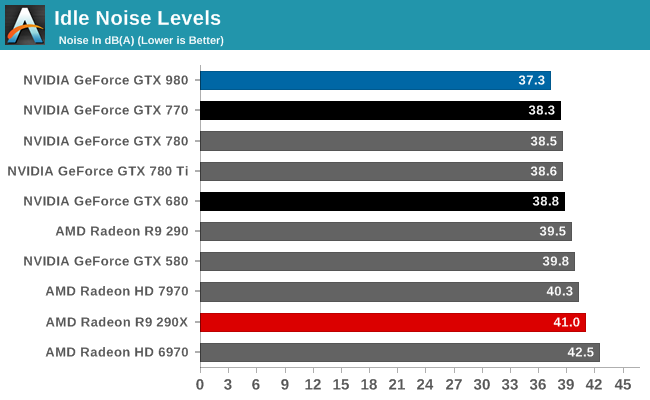
Last but not least we have our noise results. Right off the bat the GTX 980 is looking strong; even with the shared heritage of the cooler with the GTX 780 series, the GTX 980 is slightly but measurably quieter at idle than any other high-end NVIDIA or AMD card. At 37.3dB, the GTX 980 comes very close to being silent compared to the rest of the system.

Our Crysis 3 load noise testing showcases the full benefits of the GTX 980’s well-built blower in action. GTX 980 doesn’t perform appreciably better than the GTX Titan cooler equipped GTX 770 and GTX 780, but then again GTX 980 is also not using quite as advanced of a cooler (forgoing the vapor chamber). Still, this is enough to edge ahead of the GTX 770 by 0.1dB, technically making it the quietest video card in this roundup. Though for all practical purposes, it’s better to consider it tied with the GTX 770.

FurMark noise testing on the other hand drives a wedge between the GTX 980 and all other cards, and it’s in the GTX 980’s favor. Despite the similar noise performance between various NVIDIA cards under Crysis 3, under our maximum, pathological workload of FurMark the GTX 980 pulls ahead thanks to its 165W TDP. At the end of the day its lower TDP limit means that the GTX 980 never has too much heat to dissipate, and as a result it never gets too loud. In fact it can’t. 48.1dB is as loud as the GTX 980 can get, which is why the GTX 980’s cooler and overall build are so impressive. There are open air cooled cards that now underperform the GTX 980 that can’t hit these low of noise levels, never mind the other cards with blowers.
Between the GTX Titan and its derivatives and now GTX 980, NVIDIA has spent quite a bit of time and effort on building a better blower, and with their latest effort it really shows. All things considered we prefer blower type coolers for their heat exhaustion benefits – just install it and go, there’s almost no need to worry about what the chassis cooling can do – and with NVIDIA’s efforts to build such a solid cooler for a moderately powered card, the end result is a card with a cooler that offers all the benefits of a blower with the acoustics that can rival and open air cooler. It’s a really good design and one of our favorite aspects of GTX Titan, its derivatives, and now GTX 980.










274 Comments
View All Comments
Laststop311 - Saturday, September 20, 2014 - link
I'm going to wait for the custom gtx 980's. It was already throttling from reaching the 80C limit on most games. Blower design wouldn't of throttled if they left the vapor chamber in but they didnt. My case has plenty of airflow so i don't require a blower design. MSI twin frozr V open air design will cool the gpu much better and stop it from throttling during gaming. People rushing to buy the reference design are missing out on 100's of mhz due to thermal throttle.chizow - Saturday, September 20, 2014 - link
Yep the open-faced custom coolers are definitely better at OC'ing, especially in single-GPU configs, but the problems I have with them are:1) they tend to have cheaper build quality than the ref, especially the NVTTM cooler which is just classy stuff. The custom coolers replace this with lots and lots of plastic, visible heatpipes, cheapo looking fans. If I wanted an Arctic Accelero on my GPUs I would just buy one.
2) they usually take longer to come to market. Frequently +3-6 weeks lead time. I know its not a super long time in the grand scheme of things, but I'd rather upgrade sooner.
3) The blowers tend to do better in SLI over longer periods of time, and also don't impact your CPU temps/OC as much. I have a ton of airflow too (HAF-X) but I still prefer most of the heat being expelled from the start, and not through my H100i rad.
4) Frankly I'm not too worried about squeezing the last 100-150MHz out of these chips. There was a time I might have been, but I tend to stick it to a safe OC about 100-150MHz below what most people are getting and then call it a day without having to do a dozen 3DMark loops to verify stability.
Laststop311 - Sunday, September 21, 2014 - link
Did you see the benchmarks. Some games were running in the 900's some in the 1000's some in 1100's. Stuck at these frequencies because the card was riding the 80C limit. As the review mentioned these aren't the same titan coolers as they removed the vapor chamber and replaced it with regular heatpipes. Getting a custom cooled card isnt about squeezing the last 100-150 from an OC its about squeezing an extra 400-600 mhz from an OC as many reviewers have gotten the gtx 980 to OC to 1500mhz. We are talking a massive performance increase from getting the proper cooling bigger than even the r9 290x going from reference to custom and that was pretty big itself.Laststop311 - Sunday, September 21, 2014 - link
Even to get the card to reliably run at stock settings during intense gaming you need a custyom cooled card. The reference cooled card can't even reliably hit its stock clock under intense gaming because the blower cooler without vapor chamber sucks.chizow - Sunday, September 21, 2014 - link
No, you can adjust the Nvidia fan and GPU temp settings to get sustained Boosts. There is a trade-off in terms of fan noise and/or operating temps, but it is easy to get close to the results of the custom coolers at the expense of fan noise. I personally set my fan curve differently because I think Nvidia's 80C target temp profile is a little bit too passive in how quickly it ramps up fanspeeds. I don't expect to have any problems at all maintaining rated Boost speed, and if I want to overclock, I fully understand the sacrifice will be more fan noise over the custom coolers, but the rest of the negatives regarding custom coolers makes the reference cooler more appealing to me.venk90 - Thursday, September 18, 2014 - link
The GTX 980 page on NVIDIA website seems to indicate HDMI 1.4 as it says 3840*2160 at 30 Hz over HDMI (it is mentioned as a foot note). Are you sure about it being HDMI 2.0 ?Ryan Smith - Thursday, September 18, 2014 - link
Yes. I've confirmed it in writing and in person.vegitto4 - Thursday, September 18, 2014 - link
Hi Ryan, great review! There will be the usual HTPC perspective? For example, did they fix the 23.976 refresh rate as Haswell does? I think it's important to know how these work as htpc cards. RegardsRyan Smith - Thursday, September 18, 2014 - link
For this article there will not. These cards aren't your traditional HTPC cards. However we can possibly look into it for next week's follow-up.chizow - Friday, September 19, 2014 - link
I think the definition of HTPC is beginning to change though, and while these may not yet fit into traditional HTPC (Brix and NUC seem to be filling this niche more), they are definitely right in the SteamBox/BattleBox category.Honestly, SteamBox was the first thing that came to mind when I saw that 165W TDP on the GTX 980, we will be seeing a lot of GM204 variants in the upcoming years in SFF, LAN, SteamBox and gaming laptop form factors that is for sure.